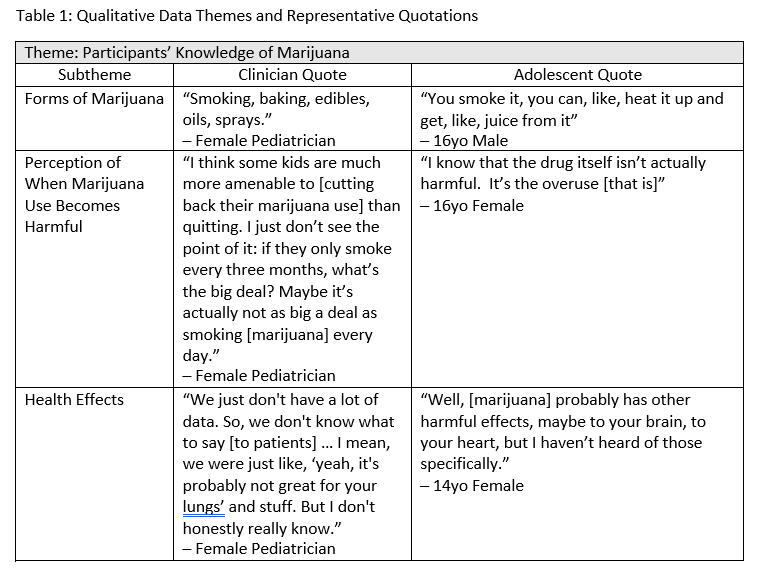Kaseeska, Kristen; Klein, Jonathan; Gorzkowski, Julie; Unger, Rebecca; Levy, Sharon; Craig, Joseph; McMillen, Robert; Pearson, Stephen; Wilson, Karen; Shone, Laura; Tait, Fan
Background: Adolescent marijuana use is common, and a significant health concern. Little research has addressed tailored interventions for casual marijuana users without substance-use diagnoses. Brief effective primary care interventions for adolescent marijuana users are needed.
Objective: To develop a brief screening and counseling intervention for use in primary care, based on the Public Health Service 5As model (Ask-Advise-Assess-Assist-Arrange) to address casual marijuana use by adolescents.
Design/Methods: Qualitative data were collected from primary care clinicians and adolescents as part of the Helping Eliminate Marijuana Use study in the AAP Pediatric Research in Office Settings (PROS) network. Four focus groups were conducted with primary care clinicians and thirteen in-depth interviews were conducted with adolescents. Purposeful sampling ensured variation by state policy on legal marijuana use. We used a semi-structured discussion guide, responses were recorded and transcribed, and three independent coders identified themes and subthemes. IRB approval included a federal Certificate of Confidentiality.
Results: 35 clinicians (77% female, 46% white) and 13 adolescents (85% female, 69% white, mean age 15y) participated. Clinicians and adolescents generally knew marijuana comes in different forms and that problematic use has harmful effects. However, adolescents perceived casual use as harmless. Most clinicians – regardless of state law on recreational marijuana– felt uninformed about the effects of marijuana use and were uncertain how to effectively counsel adolescents. Components of the 5As were well-received by clinicians and adolescents, and Advise and Assist content was seen as critical for intervention acceptability. Confidentiality was also seen as critical for truthful clinical conversations, and adolescents described trust as stemming from personalized, non-judgmental care. Clinician barriers to marijuana counseling included a lack of systematic screening tools, competing priorities, and limited confidence in their ability to address marijuana.
Conclusion: Clinicians and adolescents are aware of marijuana’s potential health impact, but are poorly informed about the effects of casual use. Adolescents and clinicians found a 5As model useful and identified delivery of Advice and Assistance in the context of confidentiality and trust as key to casual marijuana intervention acceptability.



Last Updated
10/15/2021
Source
American Academy of Pediatrics